Today is a holiday in Ferrara because it is the feast day of the City’s patron saint, San Giorgio (St George, he of dragon fame). There were no classes scheduled at the Università, so my niece and I decided that this would be a fine day to travel to Verona (she had not been there previously). At the Ferrara train station, the agent confirmed that we could make our connections and helped us purchase the tickets, and then we were on our way. In Rovigo, we got off and waited a few minutes for the connecting train to Verona; shortly after 10 am, we arrived in the city. We started walking toward the Centro Storico, and after one false turn, we found the Porta Nuova gate which led to the old city and knew we were headed in the right direction.
The first order of business was breakfast. Near the old castle, we found a reputable-looking bar on the main street and stopped in for coffee and a sandwich. The proprietor also pointed us in the direction of the Tourist Information Office, which we knew would have maps. Once armed with our map, a paper version of the large sign below, we began our touring.
In the Piazza Bra, where the tourist office is located, I started snapping photos. I don’t know why this statue is here, but Victor Emmanuel was an important figure in nineteenth century Italian history — in fact, he became the symbol of the Italian Risorgimento, the movement for Italian unification, and served at the first king of the united country.
I’m not sure of Mazzini’s connection with Verona, but apparently, there is one. Political philosopher, journalist, and all-around rabble-rouser, Giuseppe Mazzini was also a key figure in the movement for Italian unification. The two other nineteenth century statesmen considered to be fathers of the Italian nation are Cavour and Garibaldi, which you might guess from the large number of streets bearing their names.
From this piazza, we headed northeast and soon came upon this ancient Roman gate, dating to at least the second century CE but probably older.
The Piazza delle Erbe was the home of the Forum in Roman times and remains a center of commercial activity today. Close by is the alleged home of Juliet of Shakespearean fame, but we studiously avoided this tourist attraction, as by all accounts it is not genuine.
Continuing toward the bend of the river, we stopped at the Church of Saint Anastasia, where I admired the brickwork.
Close by is the Verona Cathedral, or the Duomo. This edifice was built to replace an 8th century church destroyed in the earthquke of 1117. Notice the pillars supported by griffins, which seems to be a fairly common motif.
Here we are crossing the Adige River over the Ponte Pietra, a pedestrian bridge.
On this side of the river are more ancient Roman ruins (the archaeological museum was closed for the lunch hour when we arrived).
All the guidebooks advised us to climb the steps above these ruins to the Castel San Pietro for a view of the city. That was good advice, as the view is breathtaking.
We’re looking to the northwest from this vantage point.
This is my only “We were here” photo.
By the time we descended the steps and crossed back over the river, we were very hungry. My niece quickly spotted a reasonably priced restaurant, so we chanced it and went in. The patrons appeared to be tourists, but mostly Italian tourists, so we figured it was going to be okay. We both ordered pizza, Margherita and Vegetariana, which were both good choices. Thus fortified, we began our afternoon sightseeing.
By this time we had lost our map, so we made our way back to the Tourist Information Office, walking for a bit along the Via Mazzini, Verona’s “Golden Mile” of upscale shops. On the way, we also stopped to really admire the Arena, an enormous Roman amphitheater, the third largest amphitheater to survive from antiquity, which still hosts spectacles today. The information board is advertising opera performances scheduled for the summer season.
Our last stop was the Castelvecchio, a 14th century, red brick, fortified castle on the banks of the Adige. On an impulse, we decided to explore the castle museum, which in retrospect I thought was the highlight of our visit, as it is packed with medieval and Renaissance sculpture and paintings. We happened to enter with an art history tour group led by a guy who sounded knowledgeable, so we tagged along and listened to his lectures (well, to Americans maybe everyone with a British accent sounds like an expert on everything).
Pedestrians crossing the bridge needed their umbrellas, but inside the castle, we were sheltered from the rain.
Aren’t these ramparts amazing? In the olden times, all the Italian city states were military strongholds. Between the 12th and 14th centuries, Verona was ruled by the Della Scala family, whose emblem was the ladder (scala, in Italian).
We both wanted to see the church of San Zeno Maggiore located slightly outside the city center, Saint Zeno being Verona’s patron saint, but we knew at this point that we were out of time because we had already missed our first train back to Ferrara. We walked quickly back to Piazza Bra, where we knew we could catch an 11, 12, or 13 bus back to the train station. A bus came along shortly after we found the bus stop, and a few minutes and 1.5 euros later, we were ready to board our train for the return trip. The homeward itinerary took us to Padova, where during the hour we waited for our connection, we treated ourselves to sweets from the station snack shop. By a quarter after 8, we were back in Ferrara, tired but content.


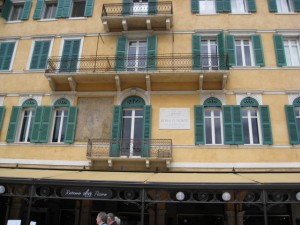
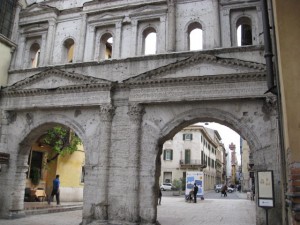




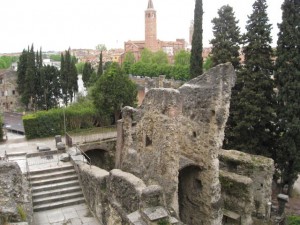
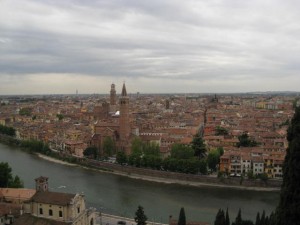




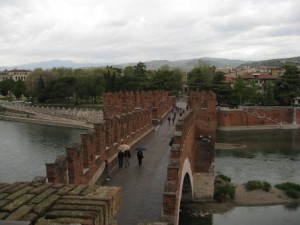

A couple notes:
– It’s Ponte Pietra – Bridge of Stone. I don’t think Piedra is an Italian word.
– Thanks for the We Are Here photo, I am stealing it for Facebook.
– The name of the ruling family of Verona – which we medievalists call a Signoria – is Della Scala (of the stair). For example, the name of an important signore is Cangrande della Scala. The adjectival form of this name is scaligera, as in la famiglia scaligera, or the two scaligeri. I think.